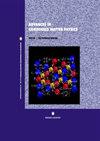Electron Transport Properties of Eu(Cu1 − xAgx)2Si2 (0 ≤ x ≤ 1): Initiation of Transition Eu2+ ↔ Eu2.41+ in the Intermediate Valence State
IF 1.8
4区 物理与天体物理
Q3 PHYSICS, CONDENSED MATTER
引用次数: 0
Abstract
The article presents the results of studies of the chemical composition, crystal structure, lattice parameters, microstructure, the valence state of the europium ion (at 300 K), electrical resistivity, and differential thermopower (6–400 K) of samples in the Eu(Cu1 − xAgx)2Si2 (0 ≤ x ≤ 1) substitutional solid solutions. A transition of the europium ion from the valence-stable state of Eu2+ in EuAg2Si2 to the state of intermediate (homogeneous) valence (IV) of the europium ion in EuCu2Si2 with an effective valence ϑeff = 2.41 (300 K) has been initiated by a successive replacement of silver atoms by copper atoms. With appropriate sample compositions, the transition passes through a Kondo-type state. The research subject is the patterns of transformations (when the composition of the sample changes), the electronic state, and, accordingly, the electronic transport properties. The simultaneous coexistence of europium ions in different electronic states is assumed. The substitutional solid solution Eu(Cu1 − xAgx)2Si2 (0 ≤ x ≤ 1) exhibits properties related to the competition between the state of the Kondo system, intermediate valence (IV), and magnetic ordering.Eu(Cu1-xAgx)2Si2(0 ≤ x ≤ 1)的电子传输特性:引发中间价态的 Eu2+ ↔ Eu2.41+ 转变
文章介绍了对 Eu(Cu1 - xAgx)2Si2(0 ≤ x ≤ 1)置换固溶体样品的化学成分、晶体结构、晶格参数、微观结构、铕离子价态(300 K 时)、电阻率和差热功率(6-400 K)的研究结果。通过铜原子连续置换银原子,铕离子从EuAg2Si2中的Eu2+价稳态过渡到EuCu2Si2中有效价态ϑeff=2.41(300 K)的铕离子中间价态(IV)。在适当的样品成分下,转变会通过一个近藤型态。研究课题是转变模式(当样品成分发生变化时)、电子状态以及相应的电子传输特性。假定铕离子在不同的电子状态下同时共存。置换固溶体 Eu(Cu1 - xAgx)2Si2 (0 ≤ x ≤ 1)显示出与 Kondo 系统状态、中间价(IV)和磁有序之间的竞争有关的特性。
本文章由计算机程序翻译,如有差异,请以英文原文为准。
求助全文
约1分钟内获得全文
求助全文
来源期刊

Advances in Condensed Matter Physics
PHYSICS, CONDENSED MATTER-
CiteScore
2.30
自引率
0.00%
发文量
33
审稿时长
6-12 weeks
期刊介绍:
Advances in Condensed Matter Physics publishes articles on the experimental and theoretical study of the physics of materials in solid, liquid, amorphous, and exotic states. Papers consider the quantum, classical, and statistical mechanics of materials; their structure, dynamics, and phase transitions; and their magnetic, electronic, thermal, and optical properties.
Submission of original research, and focused review articles, is welcomed from researchers from across the entire condensed matter physics community.
 求助内容:
求助内容: 应助结果提醒方式:
应助结果提醒方式:


